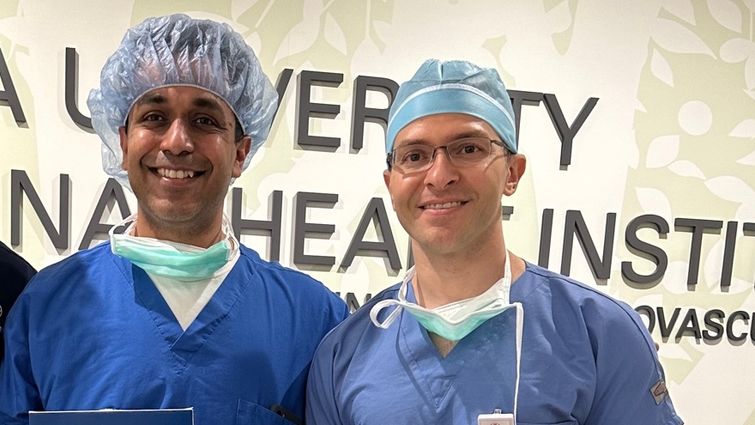
Loma Linda University International Heart Institute's Dr. Vinoy Prasad, director of interventional cardiology (left) and Dr. Amr Mohsen, structural interventional cardiologist (right) are the first in California to use a novel approach for treating blocked peripheral arteries.
Loma Linda University International Heart Institute has become the first center in the state to perform an emerging approach used to treat problems affecting blood vessels. This minimally invasive endovascular procedure combines a technique of entering a catheter through an artery in the wrist and deploying a medical device — a drug-coated balloon — in the arteries of the legs to treat blockages. This approach decreases the risk for complications and allows patients a speedier recovery.
“The beauty of this approach is that we as cardiologists can achieve much more during the endovascular procedure while also improving the experience for patients,” says Amr Mohsen, MD, a structural interventional cardiologist at LLU International Heart Institute.
Peripheral vascular disease or peripheral arterial disease affects over 8 million U.S. adults, according to the American Heart Association. It is a slow and progressive disorder of the blood vessels characterized by plaque buildup, narrowing, and obstruction to the arterial circulation supplying the extremities. Mohsen says arteries in the legs or feet are the most common arteries outside the heart to experience blockages. Such blockages reduce blood flow and vital oxygen delivery to these body parts, Mohsen says. The reduction in blood flow can cause discomfort, pain, and impaired quality of life; and, in severe cases, may predispose to other serious health risks such as heart attack and stroke.
A minimally invasive procedure called an endovascular intervention is one of the treatment options designed to control the symptoms and treat peripheral vascular disease. In a novel approach to this procedure, cardiologists at the International Heart Institute puncture the radial artery in the wrist and insert a catheter, then guide the catheter through the arteries toward blockages anywhere in the body. Once the blockage has been reached, the cardiologist deploys a drug-coated balloon — a balloon with an exterior coated with a drug that slows the growth of tissue that may cause re-narrowing of the artery. When the surface of the balloon touches the artery’s inner walls, it covers the artery's walls with a drug to prevent further blockages in that area. Cardiologists then retract the balloon without leaving a trace, Mohsen says.
Many facilities have previously used drug-coated balloons by inserting a catheter through an artery in the groin, but Mohsen says this approach proves less convenient for patients. In addition, puncturing a groin artery carries a higher risk of bleeding and other complications than inserting a catheter through the radial artery in the wrist. Mohsen says accessing a blockage via the wrist artery also enables physicians to treat blockages in both legs during the same session, which is difficult to achieve when moving the catheter through the groin artery. Finally, inserting a catheter through the wrist also causes patients less discomfort, less scarring, and quicker recovery.
Mohsen and Vinoy Prasad, MD, FACC, FSCAI, director of interventional cardiology at the International Heart Institute, performed the intervention last month on a patient with blockages in the superficial femoral artery of both legs, causing the patient severe leg pain when walking. After a 90-minute procedure involving access through the radial artery followed by treatment with drug-coated balloons, the patient returned home on the same day with all blockages cleared and in great condition, Mohsen says.
“International Heart Institute care teams are combining expertise with novel technology to keep on the cutting-edge of the cardiac care we can offer patients,” he says.
If you would like to partner with a physician to learn more about peripheral vascular disease and treatment options, visit Loma Linda University International Heart Institute online or call 800-468-5432.
